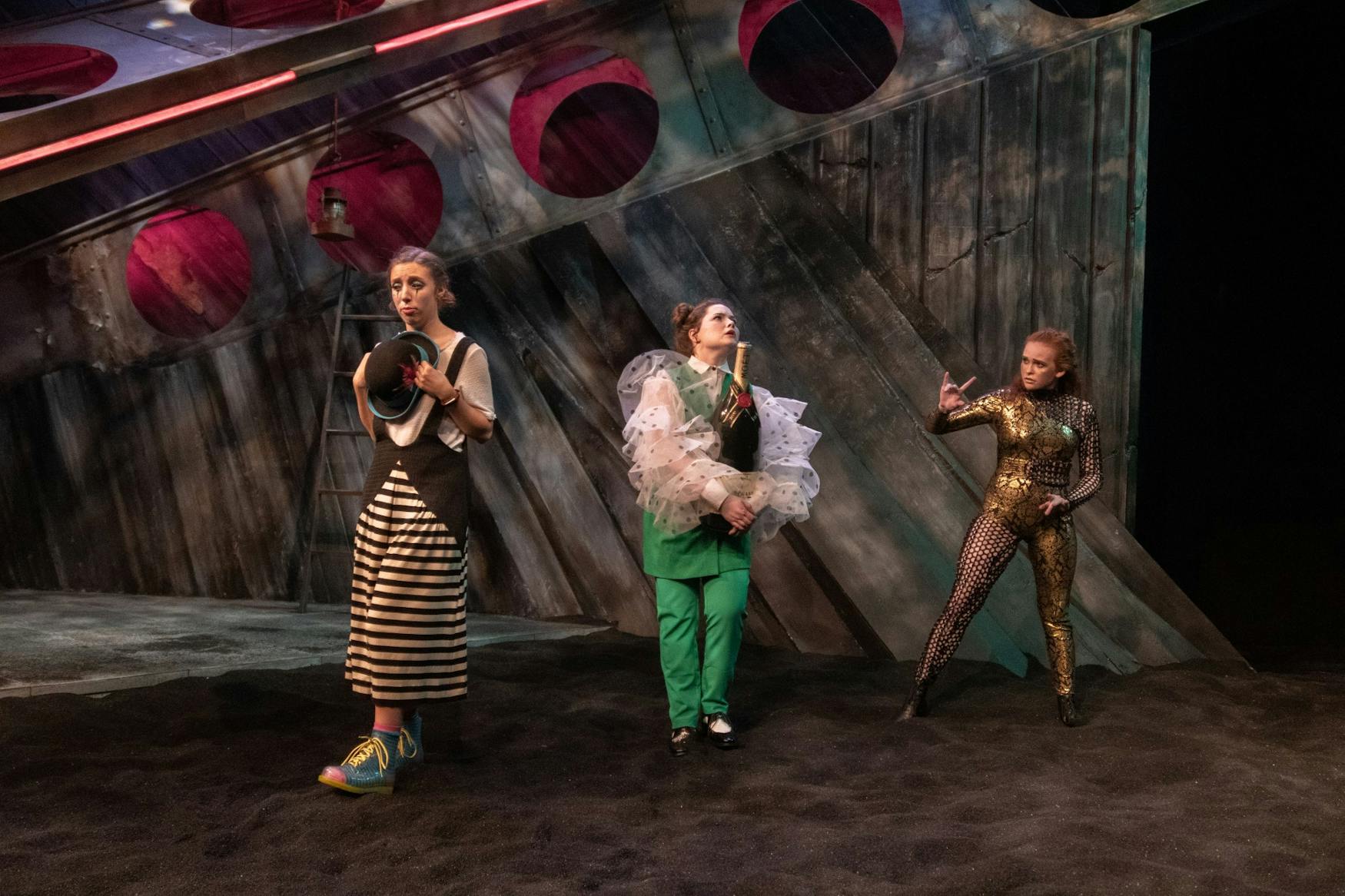The temptation of 'The Tempest'
There’s something about William Shakespeare’s “The Tempest” that keeps us feeling pulled in by the tides of time back to the shores of Prospero’s island. And this week, the mysterious and fantastical story was told in the Laurie Theater, part of the Spingold Theater Complex. It tells the story of Prospero, an Italian nobleman and sorcerer, who was marooned on a wilderness island with his daughter, only to create a magical storm to lure an Italian ship to bring them home. The crew and passengers get lost on the island, meeting its strange inhabitants and uncovering the evil plots of Prospero’s brother. This play has something for everyone: romance, fantasy, revenge, court intrigue and questions on the nature of existence itself that have shaken theatergoers to their core for centuries.
The actors have clearly worked hard to become these Shakespearean characters, and their hard work paid off. “The Tempest” has much to navigate as a modern actor, with its Elizabethan jokes, songs and philosophy lessons. I especially loved watching Renata Leighton ’21 and Grace Ahlin ’23 as the island’s whimsical and terrifying inhabitants, the spirit Ariel and feral castaway Caliban. Evelyn Inker ’23 had a commanding presence as the formidable Prospero. This character is considered to have been a stand-in for William Shakespeare himself, and Inker succeeded at filling the room with the wizard’s and the Bard’s magic and existential musings. Rosie Sentman ’22 and Rose Archer ’20 had sweet chemistry as the youthful aristocrats Miranda and Ferdinand and were just adorable to watch onstage. I also loved watching Elizabeth Hilliard ’23 and Maia Cataldo ’20 as the comedic duo Stephano and Trinculo, as they drunkenly fought and plotted their way to their own undoing over the course of the show.
Still, it can be hard to find one’s voice in acting out Shakespeare, especially when such young actors must deliver lines meant to carry the weight of age and experience. It seemed as though the actors could have used some more coaching on how to deliver certain lines, as they often fell into the trap of simply yelling lines when they wanted them to carry more emotion. There were also some moments during the show when I wasn’t sure if the actors knew exactly what their lines meant. But as I’ve said earlier, “The Tempest” is a tall order for a college production, and the cast certainly delivered the intrigue and the ‘oomph’ this play calls for, and I commend them for that.
For most Shakespeare productions nowadays, there is a postmodern urge to change various elements of the show in order to remain relevant and fresh, and this one was no exception. Some of these choices, however, held up better than others.
One of the greatest strengths of “The Tempest” is its ability to transport the audience to another world. I would have felt that here, if the production staff could have decided where it was they were transporting me to.
The show’s set consisted of two huge fallen structures, resembling steel beams of pieces of a ship, resting atop one another on the edge of a cliff face, with stairs leading up to an inner space of one of these structures, with porthole-like windows for characters to hide behind and look out of. This set gave the show a science fiction feel, with strips of LED lights on the sides of the beams changing from green to blue to red, making the whole stage feel like the inside of a spaceship. The floor of the stage had been covered in crushed black cork, making it resemble a black-sand beach, or perhaps the surface of a distant moon. This helped transform the small Laurie Theater into a menacing and eerie island, produced a dramatic effect as actors walked, ran, danced and fought across the stage.
The elaborate costumes were beautiful and fun to look at, but could not pick one aesthetic to stick to. Some of the characters sported what looked like Japanese harajuku fashion, while others looked like they had just walked out of “The Jetsons.” I would have liked its whimsical element to have been channeled into clear differences between the clothes of the island inhabitants and the shipwrecked Italian noblemen, but they were equally colorful and strange. There were a few costume pieces that were a marvel to look at, and I could tell a lot of effort was put into their crafting — notably Prospero’s elaborate magic cloak and Ariel’s giant harpy’s wings. There was clearly a lot of effort put into the costumes, but I found myself distracted by their garishness and lack of consistent style.
The sound and lighting design of this show was perhaps what drew me in the most, throwing the entire room in and out of storms and magical sleeps. The nearly-constant sound effects and music were of a movie theater caliber, and I appreciated how seamlessly the lighting shifted and altered to show different parts of the island, or to dramatize a character’s mood or intentions.

YOUNG TALENT: The actors were successful in bringing the 400-year-old play to life at the Laurie Theater.
The dramaturg’s note in the playbill explains that “we adapted the text by changing the pronouns of certain characters” in order to reflect the gender diversity of the cast itself. I have seen this done many times, but usually if productions are going to give, say, Prospero female pronouns, they will change the character’s name to Prospera. Changing the pronouns without the names is a little confusing, though the added element of gender-neutral pronouns for some characters means that names can’t just be flipped across the gender binary, because what would the gender-neutral form of “Ferdinand” be? This choice is perhaps more radical because it shows that there is nothing inherently gendered about names.
Am I saying that any Shakespeare production should stick to Elizabethan sensibility in its costuming, gender roles and set design? No, not at all. That has all been done before, and I agree that any new production needs to shake things up. However, a director and production staff must be deliberate in choosing what to modernize. It seemed like this one had chosen their aesthetic at random, and there was nothing especially novel about how they presented the story and characters. There is so much meaning to be mined from the soliloquies, conversations and relationships, especially those centered around Prospero. Shakespeare asks us, “Who is a good person? Who is deserving of forgiveness? What makes a person civilized, and who gets left out of society?” These are all timely questions, and yet the takes on them in this show were troublingly classic. There are so many ways to change the relationships in this show, but no especially bold choices were made here.
“The Tempest” is running for another weekend, and I highly encourage you to go out and see it for yourself. It is the culmination of much hard work, and the actors are a delight to watch. Go immerse yourself in the world of Prospero’s island; despite the production’s shortcomings, you may still emerge a changed person.
—Editor’s Note: As of press time, it is unclear if there will be performances this weekend due to changing University policies surrounding COVID-19.



Please note All comments are eligible for publication in The Justice.